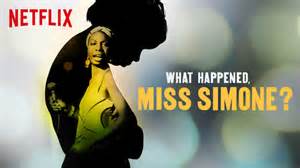 “I’ll tell you what freedom is to me—no fear,” Nina Simone wistfully told an interviewer in 1968. “If I could have that half of my life…”
“I’ll tell you what freedom is to me—no fear,” Nina Simone wistfully told an interviewer in 1968. “If I could have that half of my life…”
This search for freedom haunts each beat of “What Happened, Miss Simone,” the new Netflix-commissioned documentary on the award-winning singer, pianist and activist. The film, book-ended by Simone singing her classic “I Wish I Knew How It Would Feel To Be Free,” traces her journey from a piano prodigy in small town North Carolina to an international force of blues and soul.
“What Happened, Miss Simone” reaches viewers months before the highly controversial “Nina” biopic—in which Afro-Latina actress Zoe Saldana dons facial prosthetics to more closely resemble Simone. Simone’s only child, Broadway actress Lisa Simone Kelly, prefers the documentary: “[This film] reboots everything to what it’s supposed to be in terms of mom’s journey and mom’s life the way she deserves and the way she wants to be remembered in her own voice on her own terms.”
Born Eunice Waymon in 1933, the young girl’s early aptitude for music inspired a rare communal pride in her segregated town: both black and white residents contributed to a fund to send her to the Juilliard School in New York. When she applied to the Curtis Institute of Music in Philadelphia, the admissions office turned her down. “It took me six months to realize it was because I was black,” Simone said. (The institute would later award her an honorary degree two days before her death in 2003.)
Fresh out of money, the 19-year-old took the first job she could find—playing piano in an Atlantic City bar: “The owner came in the second night and told me if I wanted to keep the job, I had to sing. Ninety dollars was more money than I ever heard of in my life, so I sang.”
She changed her name to Nina Simone to avoid having her preacher mother discover she was playing secular music for a living. Yet it was the classical training that made her stand out. Soon she found herself performing at jazz festivals, drawing attention with her booming vocals.
“What I was interested in was conveying an emotional message, which means using everything you’ve got inside you, sometimes to barely make a note, or if you have to strain to sing, you sing,” she explained. “So sometimes I sound like gravel and sometimes I sound like coffee and cream.”
Her then-husband Andrew Stroud quit his job as a New York City police sergeant to oversee her career. Mutual friends described him as a man who could spook you with one word; their love affair quickly turned violent.
“Andrew protected me against everybody but himself,” she spat in one interview. “He wrapped himself around me like a snake.”
While Simone aspired to commercial success, the relentless pressure of being the breadwinner for an entire entourage— at one point she counted 19 people on her payroll—exhausted her: “Inside I’m screaming, ‘Someone help me’ but the sound isn’t audible – like screaming without a voice,” she wrote in her journal. “Nobody’s going to understand or care that I’m too tired. I’m very aware of that,” she later said.
Stroud recounted a story of Simone having a mental breakdown before a performance. “She had a can of shoe polish. She was putting it in her hair. She began talking gibberish and she was totally out of it, incoherent.” No one took her to get help; instead, Stroud took her arm and escorted her to the piano on stage. The show must go on.
Kelly, who also produced the film, uses her screen time to “explain” her mother, to smooth some of the controversial aspects of the entertainer’s life. For the most part, she is successful: “She was happiest doing music. I think that was her salvation. It was the one thing she didn’t have to think about.”
As her marriage imploded, Simone entered the burgeoning civil rights movement, flourishing in the company of contemporaries like James Baldwin, Lorraine Hansberry and Langston Hughes. “I could let myself be heard about what I’d been feeling all the time.” The 1963 bombing of the 16th Street Baptist Church that killed four little girls enraged her. She wrote “Mississippi Goddam,” which soon became her best-known song and an anthem of the movement.
As Simone’s priorities shifted to what she called “civil rights music,” promoters shifted away and her career stalled. After stints in Barbados and Liberia, she settled in Europe to mount a comeback. Friends took in her disheveled appearance and odd behavior and took her to the doctor, where she was diagnosed with bipolar disorder, a disease many suspected she struggled with most of her life.
It’s never quite clear how close Simone would have considered some of the individuals tapped to interview; director Liz Gruber’s decision to gloss over their connection weakens the film. But the inclusion of Simone’s journal entries—she talks about contemplating suicide, of taking pills simply to function—gives an unvarnished insight into a woman of genius whose complexity makes her difficult to sum up, or pin down.



